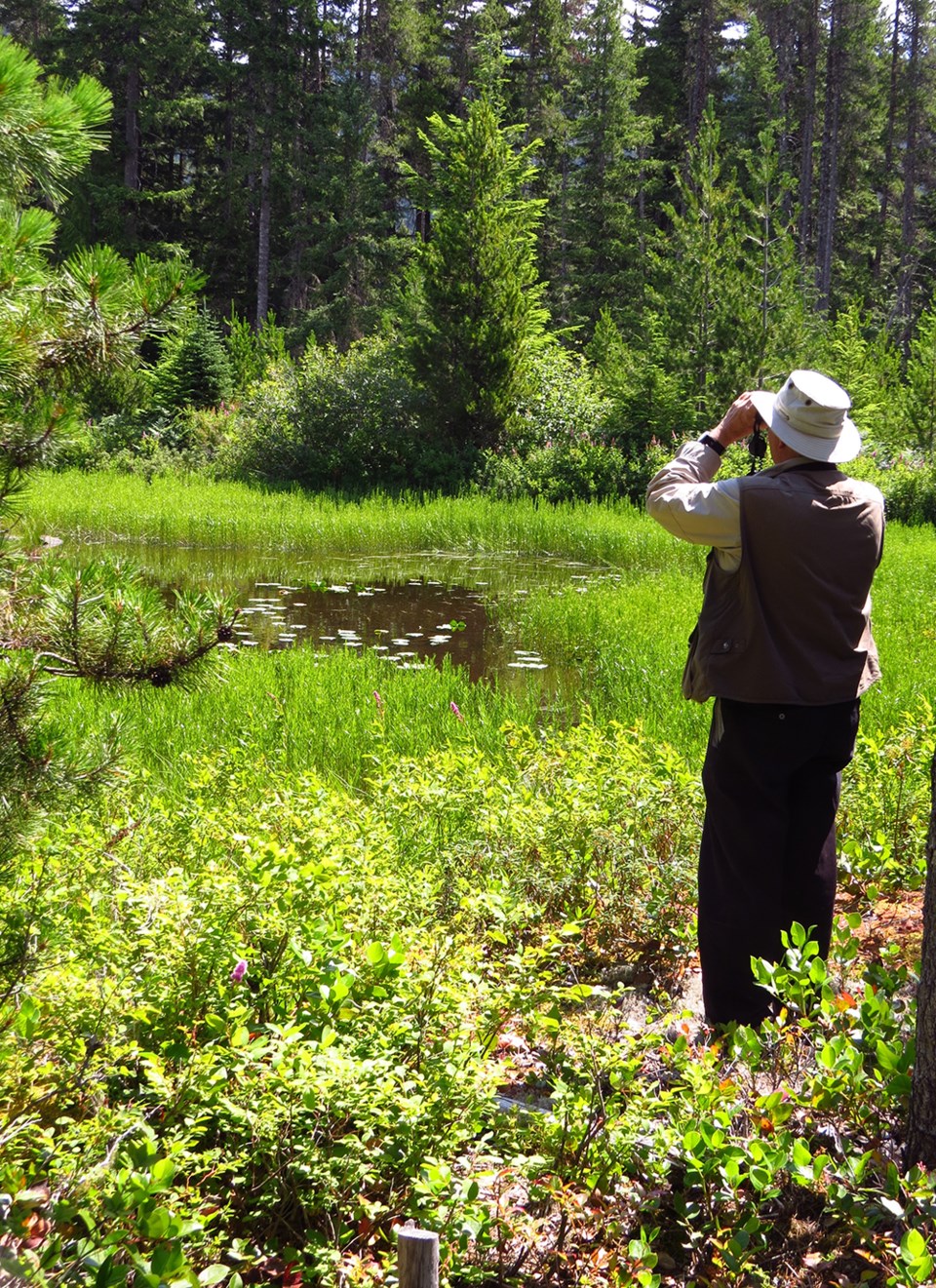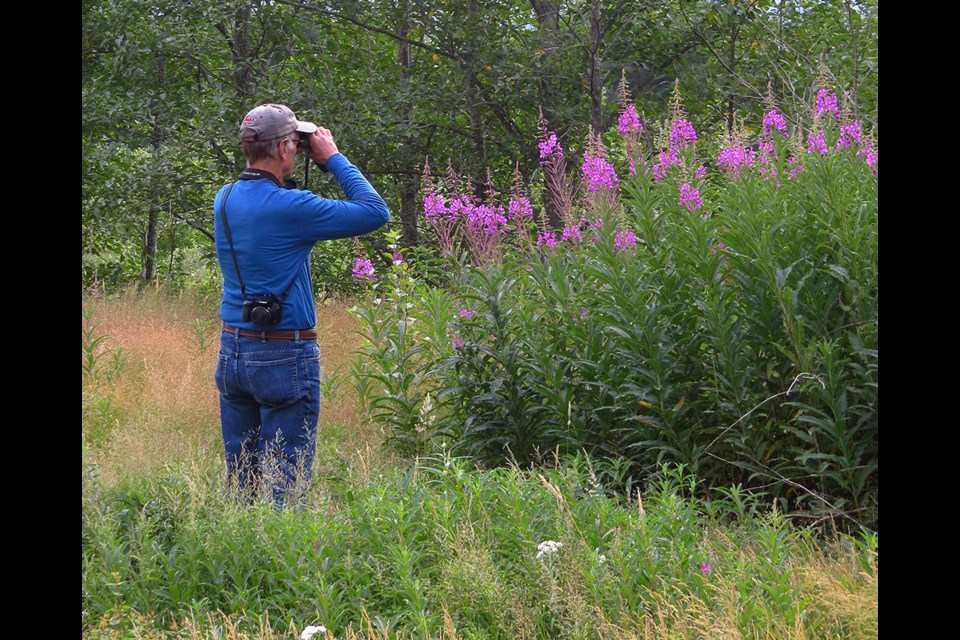“The trouble with birding,” explained Carl Halvorson, chair of the Squamish Environment Society, “is if you try it with good intention you will enjoy it… you might even get hooked.”
It’s an inexpensive hobby that can take place as close to home as your own back yard, or as far around the world as you wish.
And it may be a great deal more exciting and rewarding than you think, he explained, especially when armed with a pair of binoculars – or ‘scopes’ as the pros call them.
“I went to Costa Rica on an environmental tour… and there were these pretty, non-descript little brown birds and little green birds everywhere. Then, all of a sudden, we were given a check list to mark off the birds when we saw them. It became this obsession about how many birds you could get on your list. Then the obsession turned into, ‘Gosh, that’s a pretty bird, what a beautiful sound,’ and you start wanting to see or hear them just for themselves as opposed to it being for a game.”
Marcia Danielson, fellow member of the environment society, began birding when she was just 21 years old while working at the University of Manitoba.
It’s a great opportunity to get out, she explained, and one that she now enjoys sharing with her grandchildren.
“Birding, for me, is just a euphemism for wandering around out there in the fields and forests and just being immersed in nature. It draws me outside, which is where I’d rather be than anywhere else,” she said.
Bird watching also helps recharge her batteries and keeps her mind active, she explained, especially over the past 10 years which she’s spent honing her listening skills to recognize individual bird song.
From spotting songbirds in her backyard, to viewing flamingos in Florida and observing rare, resplendent quetzals in Ecuador, birding is now a huge part of Danielson’s life and travels.
It’s also a love she shares with her husband – though she’s quite a bit better at it than him she said.
If there’s a bird count in town, it’s likely been organized at least partly by Danielson or her husband, Grant, including the Christmas bird count, the eagle count, the monthly bird count, and the annual owl count.
While the owl count is one of the only counts that happens under the cover of darkness, the majority begin before most people have had breakfast.
It’s a beautiful time of day, Danielson explained, and a great way to experience birding for the first time.
“Bird counts are a good way to start birding because there are always people there who are knowledgeable about birds... and we’re more than happy to teach people, because it’s something we love to share,” she said.
April, May and June are also the busiest times for spotters, as it’s the breeding season, so it can be a fun time to begin birding, Danielson explained.
“If you come for the first time,” Halvorson added, “there seems to be a lot of wandering around, not really doing anything. And then you see a bird. And there’s a bluebird. And there’s another one. And it gets quite exciting. It seems all nerdy and weird… but it can be really fun and really rewarding. Everyone should give it a go. And hopefully you have a sunny day and come away thinking, I want more of this.”
And, just occasionally, Danielson added, you might see something astounding.
Two years ago she saw a bird sitting on top of a little squat spruce in a meadow.
“And just as I picked up my binoculars it turned its face and looked at me and I realised it was a Great Grey Owl, said Danielson.
“The first time ever in Squamish.”
She visited the owl every day after that. “It would fly in right beside me and hunt. They’re spectacularly huge birds.”
Unfortunately, word about the owl-sighting spread and Conversation Officers had to step in to stop onlookers harassing the bird.
There are rumours though that it may not have flown all that far away, however, Danielson has yet to see it again.
Though the environment society is involved in many aspects of local wildlife and habitat preservation, birding plays a huge role within the society and, for about 30 years, a core group of volunteers has gone out no matter what the weather to conduct the monthly bird count in Squamish.
The huge catalogue of data is now with Quest University being analyzed, though Danielson has a gut feeling about a few patterns they might see.
“There are species moving in that were previously never in Squamish or the estuary,” she said, and added that bushtits, Virginia rails, and Anna’s humming birds are now being seen here, like never before.
“On the other side of it, five years ago I’m thinking I would see or hear a lot more red-breasted nuthatches than we are seeing now… I used to have them in my yard but more big houses have moved into this neighbourhood, forests have been cut down and we’re removing the things that these birds need.”
In addition to these shifts in species, some she feels have suffered a dramatic loss in numbers, and recalls previous years when she’d see 200 sea ducks at a time on the water in the winter.
“Now you don’t see that… but maybe we’re going to see a reversal as Howe Sound improves in health.”
Squamish has been designated as an ‘Important Bird Area’ by BirdLife International and, according to the District of Squamish website, provides habitat for over 200 species of local and migratory birds.
“It’s incredibly rich for numbers of species and numbers of individuals,” said Danielson, and it pains her to see industrial parks spreading and forests being cut down.
On the positive side, Halvorson said he’s attended meetings where representatives from industry have spoken up for the protection of wildlife corridors.
He’s also grateful that much of the development is dense and not sprawling.
“I’d rather have 80 people standing on their heads than 80 people spreading across the land,” he said.
The Squamish Environment Society works tirelessly behind the scenes here in Squamish to preserve wildlife and their habitats, and, like so many local organizations, relies on volunteers to succeed – a resource that is often in short supply.
If you would like to become involved, monthly bird counts begin and end at the Howe Sound Brew Pub on the second Sunday of every month.
There are also monthly nature walks and local events.
For more information go to www.squamishenvironment.ca.





